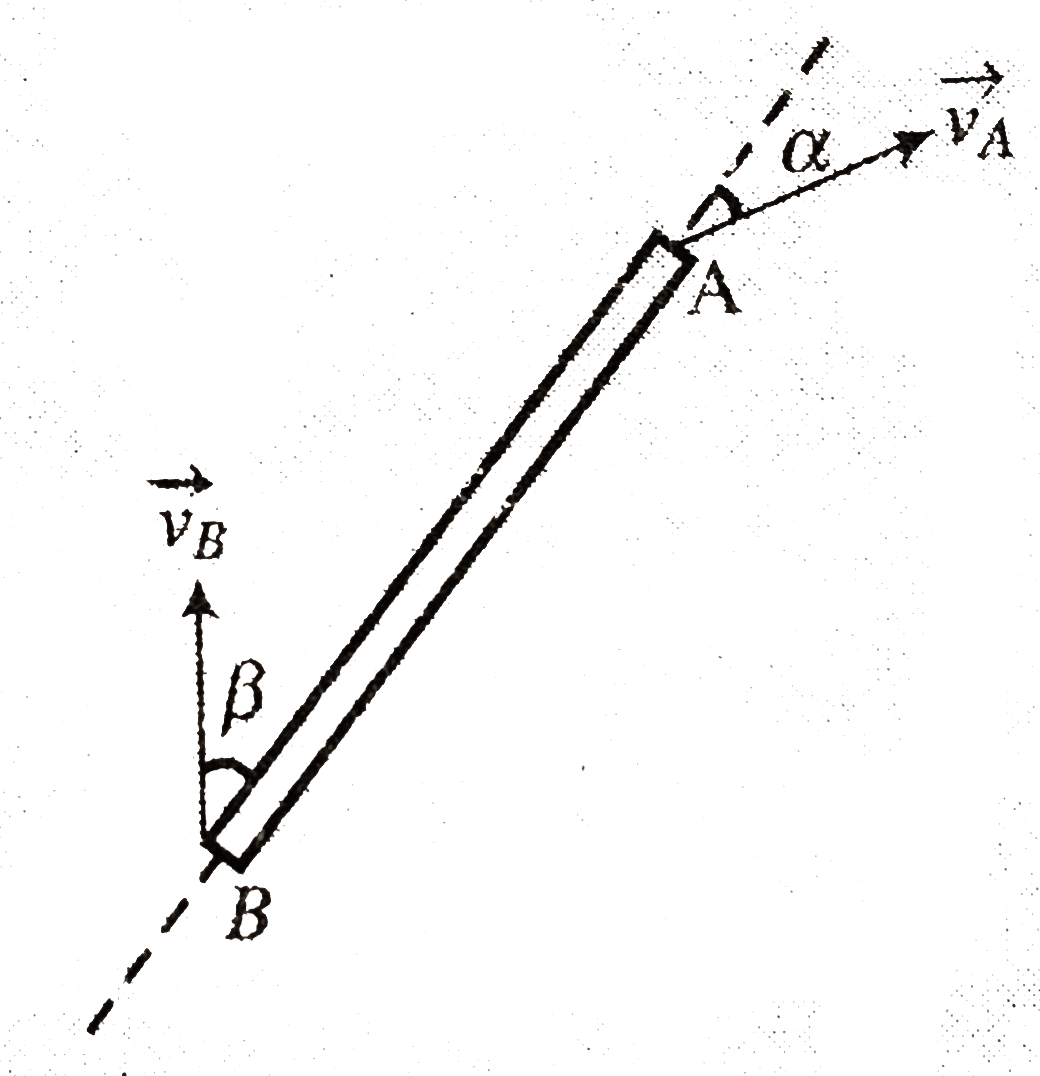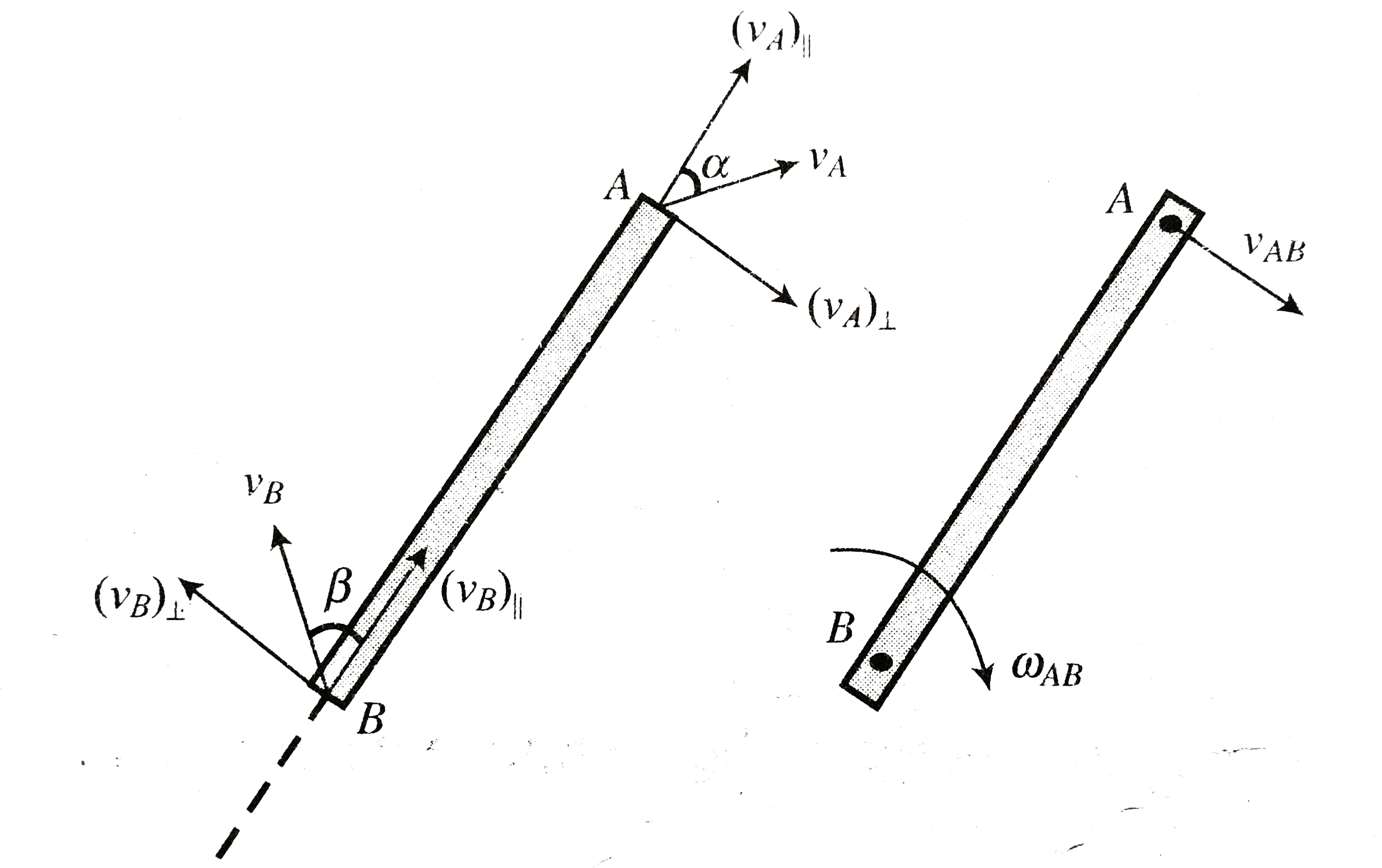The ends A and B of a eod of length l have velocities of magnitudes |→vA|=v and |→vB|=2v respectively. If the inclination of →vA relationn to the rod is α find the
a. Inclination β of →cB relative of the rod.
b. angular velocity of the rod.


We know in a rigid body the velocities of two points along the line joining two should remain same.
i.e., (vA)∣∣=(vB)∣∣
Hence vcosθ=2vcosβ
cosβ=12cosα or β=cos−2(12cosα)
b. for angular velocity of the rod we can write
ω=∣∣(→vAB)⊥∣∣l=∣∣(→vA−→vB)⊥∣∣l
|→vAB|=|→vA−→–––(B)|=vsinα(−2vsinβ)=v(sinα+2sinβ)
⇒ω=(sinα+2sinβ)vl (in clockwise direction)
we have calculated cosβ=cosα2. Thus,
sinβ=√1−cos2β⇒sinβ=√3+sin2α2
Hence ω=sinα+√3+sinαl ( in clockwise direction)
Topper's Solved these Questions
- RIGID BODY DYNAMICS 1BOOK - CENGAGE PHYSICS ENGLISHCHAPTER - RIGID BODY DYNAMICS 1EXERCISE - Solved Examples
9 Videos
- RIGID BODY DYNAMICS 1BOOK - CENGAGE PHYSICS ENGLISHCHAPTER - RIGID BODY DYNAMICS 1EXERCISE - Exercise 2.1
6 Videos
- PROPERTIES OF SOLIDS AND FLUIDSBOOK - CENGAGE PHYSICS ENGLISHCHAPTER - PROPERTIES OF SOLIDS AND FLUIDSEXERCISE - INTEGER_TYPE
2 Videos
- RIGID BODY DYNAMICS 2BOOK - CENGAGE PHYSICS ENGLISHCHAPTER - RIGID BODY DYNAMICS 2EXERCISE - Interger
2 Videos
Similar Questions
Knowledge Check
Suppose that two objects A and B are moving with velocities →vA and →vB (each with respect to some common frame of reference). Let →vAB represent the velocity of A with respect to B. Then
A→vAB+→vBA=0B→vAB−→vBA=0C→vAB=→vA+→vBD|→vAB|≠|→vBA|
Two objects A and B are moving in opposite directions with velocities vAandvB respectively, the magnitude of relative velocity of A w.r.t. B is
View SolutionA rod of length l is moving in a vertical plane (x−y) when the lowest point A of the rod is moved with a velocity v. find the a angular velocity of the rod and b velocity of the end B.

View SolutionA uniform rod of mass M and length a lies on a smooth horizontal plane. A particle of mass m moving at a speed v perpendicular to the length of the rod strikes it at a distance a4 from the centre and stops after the collision. Find a. the velocity of the cente of the rod and b. the angular velocity of the rod abut its centre just after the collision.
View SolutionFind the instantneous axis of rotation of a rod length l when its end A moves with a velocity →vA=Vi and the rod rotates with an angular velocity →ω=−v2lˆk.

View SolutionA rod AB of length 2m moves in horizontal x−y plane. At any instant end a of the rod is at origin and has velocity →vA=2ˆi+vyˆj. The other end B at the same instant is moving with velocity →vB=3ˆi+6ˆj. The rod makes an angle of 30∘ with the x−axis at this instant (see figure)
The magnitude of angular velocity of the rod is

View SolutionA rod AB of mass M and length 8l lies on a smooth horizontal surface. A particle, of mass m and velocity v0 strike's the rod perpendicular to its length, as shown in Fig. As a result of the collision, the centre of mass of the rod attains a speed of v0/8 and the particle rebounds back with a speed of v0/4. Find the following: a. The ratio M/m. b. The angular velocity of the rod about O. c. The coefficient of restitution 'e' for the collision. d. The velocities of the ends 'A' and 'B' of the rod, namely, vA and vB respectively.

View SolutionThe instaneous velocity of point B of the given rod of length 0.5 is 3m/s in the represented direction. The angualr velocity of the rod for minimum velocity of end A is

View Solution

